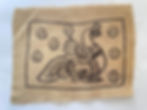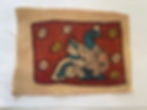KALAMKARI is a hand-painted or block-printed cotton (and modern-day silk, wool) textile, produced in parts of India and Iran. Its name originates in the Persian, قلمکار which is derived from the words qalam (pen) and kari (craftmanship), meaning drawing with a pen. Only natural dyes are used in kalamkari and it involves seventeen steps.
There are two distinctive styles of kalamkari art in India – the Srikalahasti style and the Machilipatnam style. The Machilipatnam-style takes the form of block printing, while the Srikalahasti style of kalamkari, uses the “kalam” or pen for freehand drawing of the subject and filling in the colors, and is entirely hand-worked. This style traveled with the "Chitrakars" and flowered around temples. Their patronage had an almost religious identity – scrolls, temple hangings, chariot banners, and the like, depicted deities and scenes taken from Hindu mythology, folklore, and everyday life.
Tie-dye, block printing, and other painting techniques are seen and practiced in many parts of India and the world. Sri Kalhasti is one of the few places in the world that still carries the practice of making a kalam and painting entirely freehand with natural dyes.

Machlipatnam Kalamkari, ca. 1770-80, V&A Museum

SriKalahasti Kalamkari, 1881-82, V&A Museum
Through trade and cultural exchanges along the Silk Road, the craft was influenced by Persian or Islamic art forms. The Mughal Kings highly nurtured it in the 14th century.
Kalamkari gained popularity among European traders during the colonial period between the 16th and 18th Centuries. These textiles with deep colors and impeccable craftsmanship were traded to the West, where they were popularized as Chintz. The European Chintz market was initially characterized by high-quality, low-quantity trade.
But by the 19th and early 20th centuries, Kalamkari faced challenges due to industrialization and the British wanting to re-direct profits to them. The British exported raw materials (dyes, pigments, and raw cotton) to England and imported cheap replicas of mill-made products. This led to the diminishing of craft within the artisans. However, efforts by artists and enthusiasts to revive Kalamkari traditions post-independence contributed to its resurgence.
PROCESS OF KALAMKARI
The process of Kalamkari is 100% natural. It is done using only natural dyes, mordants and tools on natural fibered cloth. The process integrates history, geography and culture onto textile.
A Kalamkari undergoes 17-23 steps over 3-4 weeks. Depending on the size and intricacy of the story a Kalamkari piece can take anywhere between 4 weeks and 1 year to make.
STEPS
The cloth is bleached in water and subsequently dried in the sun for a few hours.
The cloth is treated (Soaked) in Myrobalan nut solution. Cow or Buffalo milk is added to the solution to prevent the color from spreading in the next step.
The iron acetate solution (Kasimkaram) is filled in either for solid spaces or as outlines for black color.
All the areas meant to be Red are painted over with the Alum solution as a mordant.
After applying Alum the cloth is kept for at least 24 hours, and the excess mordant is removed by washing the cloth under flowing water.
The Red color is made by boiling the fabric with red pigment in water. Red pigment is derived from the root of Indian Madder or Bark of Buckthorn.
The cloth is treated a second in Myrobalan mixed milk solution.
The alum is painted on again. This is to differentiate between the background Red and the Reds in the figures, which should be lighter than the background.
The alum-painted cloth is re-washed in the flowing water and is boiled in Red pigment material for the second time.
The cloth is treated with milk.
Yellow color derived from flower of myrobalan or rind of pomegranate fruit is painted on.
It is again washed in flowing water.
The cloth is painted with Blue Indigo, which is derived from leaves of indigofera tinctoria.
It is again washed in flowing water.
To get a green tinge, yellow areas are painted over.
The fabric is finally washed in the river.
The river carries minerals that bring out rich colors of the pigment.










The aim during the revival of Kalamkari in the 1950's was or artisans to get a livelihood from their craft. The Sri Kalahasti style shifted from story cloths to fashion, lifestyle, and interiors. It shifted from writing stories to painting. And with fast fashion superseding in the last few decades; Kalamkari is losing its authenticity. About 80% of the artisans today are now producing “kalamkari” which are screen printed, use chemical dyes, and many of the younger generations don't even know how to use a kalam. They look at techniques suited to mass production and equalize it to kalamkari. And when asked them about kalamkari's made by their forefathers, they shrugged their shoulders and said “Something that’s very time-consuming, a skill they din't continue practice since there is no demand for it".
References and Sources:
Indian Textiles in the East, John Guy
Victoria and Albert Museum www.vam.ac.uk
Craft Atlas craftatlas.co
Wikipedia en.wikipedia.org/wiki/Kalamkari
Mamata Reddy
Qualitative research by Nikita Shah via interviews with P. Nagaraj, Govardhan, Vishwanath Reddy, Thilak Reddy and organizations like Bhanodaya, Kala Srusti. Sri Kalahasti, India 2023.